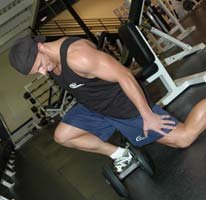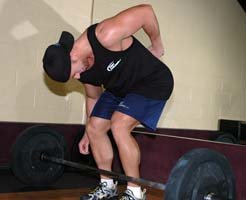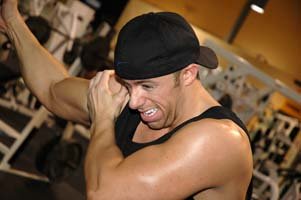Many of us at some point in our life have probably experienced a muscle cramp. The pain that it brings is something that isn't forgotten, and is something a person does not want to experience again.
Most people do not understand what a muscle cramp is, let alone understand why it happens and how to prevent them. This article will give you all the information you need to fully understand muscle cramps.

What Is A Cramp? 
A muscle cramp is an involuntarily and forcibly contracted muscle that does not relax. Muscle cramps normally last from a few seconds to up to fifteen minutes. On rare occurrences they can last longer than fifteen minutes. A cramp can persist numerous times until it eventually goes away. Cramps can effect the muscles differently - for instance it can affect a group of muscles, a single muscle, or even a specific part of a muscle.
 Who Can Get A Cramp?
Who Can Get A Cramp?
Cramps are very common not only in athletes, but also in someone who is sedentary all day long. Children and seniors alike can be victim to cramping. Aging is a nasty concept-and unfortunately as you age, your chance of frequent cramping increases.
| RELATED ARTICLE | ||
|
 Can All Muscles Cramp?
Can All Muscles Cramp?
All skeletal muscles can cramp at any given moment. A very common cramp that majority of the population has experienced one time or another occurs with the calf muscle (named a "charley horse"). Most cramps occur in the extremities especially with the legs.

Are There Different Types Of Cramps?
Cramps are classified according to the muscle groups they affect and their different causes. There are four types of skeletal muscle cramps:
- True cramps
- Contractures
- Tetany
- Dystonic cramps
1. True Cramps:
True cramps are caused by hyperexcitability of the nerves of a muscle. They can involve part or a whole muscle group. True cramps are the most common type of skeletal muscle cramp. These types of cramps can occur due to many factors.
Vigorous Activity:
When playing sports, muscle fatigue as well as vigorous use of the muscles can cause cramping. These cramps can occur either during or after the activity. Older individuals are at a higher risk for cramping while doing any type of intense physical activities.
Just the opposite case can also cause muscle cramping. If an individual is lying or even sitting in an awkward position for a long period of time cramping can result.
Injury:
An injury alone can cause cramping. Cramping can occur as a protective mechanism following an injury. In this case, the cramp occurs to stabilize the injury and to minimize movement from that area.
Dehydration:
Dehydration is mainly caused by warm weather in which it can be an early sign of something more serious such as heat stroke. Athletes and those individuals who are doing vigorous activities are more likely to become dehydrated due to fluid loss from perspiration.
| RELATED ARTICLE | ||
|
Bodybuilders are commonly found using products such as diuretics to push out any extra water they are carrying so that their definition will be better on stage. While trying to put out the water, many bodybuilders lower sodium levels so they do not retain any water that they lost. This loss of sodium can cause dehydration and cramping. That is why when someone is cramping, they sometimes give them a salt tablet to take with some water.
Low Potassium Levels:
When potassium levels are low, muscles are weakened and muscle cramps can occur. Eating bananas will help keep potassium levels normal so that the chances of cramping are minimized.
Low Blood Calcium, Magnesium:
When there are low levels of calcium or magnesium in the blood, nerve endings and muscles are affected. This can be caused by diuretics, inadequate calcium and magnesium in the diet, inadequate vitamin D in the diet, and excessive vomiting. The excitability of muscles and nerve endings are increased when there are low blood calcium and magnesium levels which cause muscle cramping.
Rest Cramps:
Older individuals as well as children can suffer from rest cramps. Rest cramps are mainly experienced during the night. These cramps are disruptive to sleep but are not life-threatening in any way. Rest cramps can happen on any given night and even many times a night.
A common place to experience rest cramps would be in the calf. Rest cramps in the calf at night are due to a shortening of the calf muscle which can happen while lying in bed and pointing your toes down. Even though they understand how you get a cramp in your calf at night, the cause of night cramps is still unknown.
2. Tetany:
Tetany is a type of cramping which activates all of the nerve endings in the body. This then effects the muscles of the body and cramping occurs throughout the body. Tetany cramps also affect other nerve functions of different muscles and areas of the body.
For instance, when there is a low blood calcium level in the body (similar to a true cramp), there could be a cramping of the arm yet the individual could also feel tingling and numbness around the mouth or other areas.
3. Contractures:
Contractures occur when the muscles aren't able to relax. They are caused by the depletion of ATP (adenosine triphosphate). ATP is a source of energy within the cell which is used by the muscles to do work. Because of this depletion of ATP in the cell, it does not allow the muscle fiber to relax. This form of muscle spasm occurs without nerve activity. This type of cramp can either be acquired or inherited.
| RELATED ARTICLE | ||
|
4. Dystonic Cramps:
Dystonic cramps are where a muscle that is not needed for a movement is contracted. For instance, the cramp would occur with a muscle that is working in the opposite direction of the intended movement. These types of cramps usually effect the smaller muscle groups such as the jaw, eyelids, larynx, etc.

What Can Cause Cramping? 
There a numerous medicines out there that can cause cramping. One example would be anything containing a diuretic. Individuals with vitamin deficiencies such as thiamine (B1), pantothenic acid (B5), and pyridoxine (B6) can cause cramping.
 View Vitamin B Products Sorted By Top Sellers Here.
View Vitamin B Products Sorted By Top Sellers Here.

Symptoms & Diagnosis
What Are The Symptoms Of Common Muscle Cramps & How Are They Diagnosed?
A cramp is painful and will stop an individual in its tracks until the cramp is taken care of and relieved. During a cramp, the muscle will be tender and will be bulged and firm. The muscle that is cramping will not be able to be used until the cramp is gone. In some cases, sever cramping can cause inflammation and soreness for several days after the cramp occurred.
There are no tests for cramps-however, most individuals know when they have a cramp.

Treatment
What Is The Treatment For Muscle Cramps?
When a muscle cramp occurs, if the muscle can be stretched, the knot will be released and the cramp will go away. In most cases when a cramp is in the lower extremities, by walking around it should loosen the knot in the muscle and the cramp will go away.
For cramps in the hand and forearm, an individual can release cramp by pressing their hand on a flat surface, which will stretch out the muscles in the hand as well as the forearm.
Another technique to relieve a cramp would be to apply a warm heating pad. If the individual is cramping due to dehydration/fluid loss, ice packs may help relieve the cramp. If dehydration is the cause, the individual should also take in some fluids and electrolytes. Another technique an individual could use to relieve a common muscle cramp would be to massage the effected muscle, which will help the muscle relax and relieve the tension.
| RELATED ARTICLE | ||
|
There are no medicines prescribed for cramps. Since cramps vary due to situation, there is nothing that can be used to cure cramping when it happens. Also, a cramp comes and goes fairly quickly, therefore the cramp would be gone by the time any medicine would actually kick in.

How Can Muscle Cramps Be Prevented?
 Activity:
Activity:
If you are prone to cramping during exercising, it is best to stretch before and after the activity. It is also smart to warm-up and cool down properly. Also, make sure you are properly hydrated before, during and after the activity.
 Dystonic Cramps:
Dystonic Cramps:
These types of cramps can be avoided by paying attention to ergonomic factors which could cause the cramping. Another factor to help prevent dystonic cramps would be to avoid excessive tension while performing the activity, which normally causes the cramping.
 Rest Cramps:
Rest Cramps:
Rest cramps can help be prevented by making sure you stretch regularly (especially before bed if you suffer from night cramps). It is also important to make sure you have adequate calcium and magnesium levels, which can help prevent night cramps. An additional dose of calcium before bed will suffice and help prevent cramps.
| RELATED POLL | |||
|
|||









